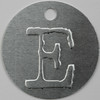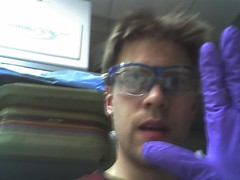As mentioned previously, I attended a excellent presentation by
Dr. Theodore Berger--directer of USC's
Center for Neural Engineering--titled "
Toward Replacement Parts for the Brain: Implantable biomimetic microelectronics as neural prostheses for lost cognitive function."
First, let's start off with a fairly simple overview of what his research is intended to accomplish. Different classes of
neural prostheses can be differentiated by which point in the input/output cycle they act in:

(
flowchart design ripped off from Dr. Berger's powerpoint presentation)
Prostheses operating at either end of the system are more well-known.
Cochlear implants are getting to be commonplace, a hefty amount of work is going into
retinal implants, and we're also starting to see some movement in neuromuscular prosthetics. The collaboration Dr. Berger is heading, however, is the first project I've encountered that is centered on utilizing a
brain implant bridging a gap between A & C.
The group has wisely chosen to focus its work on replacing damaged pathways in the
hippocampus. More electrophysiology research has probably been conducted in the hippocampus--or HPC--than any other region of the brain. The HPC can be potentially modelled as basically acting as a way-station for the
consolidation of memories: it's fed short-term memories, and encodes them in
neocortex as long-term memories. This input/output function (very) roughly follows the pathway:
entorhinal cortex (input) --> Dentate gyrus --> CA3 --> CA1 --> subiculum (output)
CA3 & CA1--along with the very small CA2--make up the hippocampus proper.
So the stated goal of Berger's project is to create an implantable
biomimetic model device which mimics the signal processing functions of CA3. In human patients, this would mostly be useful for treating
anterograde amnesia, most popularized in the film
Memento.
So how does one go about replacing a--admittedly small--region of the brain with an implant? The project seems to be broken up into three phases:
Phase 1: Hippocampal Slices
Phase 2: Live rats
Phase 3: Live primates
Each of these phases is broken up into three stages of evolving approach:
Stage 1: Mathematical modelling
Stage 2: Software modelling
Stage 3: Hardware modelling
Phase 1--brain slices from hippocampus--is entirely complete. The project seems to be on the cusp of transitioning from stage 2 to stage 3 on live rats. So let's take a look at what they've accomplished so far:
The key problem they're centering their work around is duplicating--and accurately predicting--patterns of output in response to patterns of input. Brain activity is generally portrayed in a fairly simple fashion: either a neuron receives a strong enough collection of signals to undergo an action potential or it doesn't. Since action potentials are all-or-nothing affairs, all that matters is determining whether or not the neuron fires. However, whether or not a neuron fires an AP is influenced not only by the current pattern of input, but also by previous patterns of input.
They dealt with this by taking comprehensive readings of CA3 output while subjecting it to a widely ranging random series of stimulations based on
Poisson's equation (don't ask me about the math--see
the previous entry). They then took systems analytic approaches from engineering to determine how each section responds to the input. This was based on a bunch of equations and techniques I'd never heard of: I currently have "
Volterra kernel estimation on a
Laguerre basis" written in my notes, if you find that useful. The end result is a third order nonlinear model which takes as x(n) the input from the dentate gyrus to CA3 and returns y(n), CA3's output to CA1.
This is fairly impressive: as a third order equation, it only needs to track the previous two input bursts in order to predict the response with 95% accuracy. I would have guessed that they needed to track a lot more than that. But at the same time, they're intentionally simplifying the model (as Dr. Berger kept putting it, a number of aspects of their approach were based on the "Give Us A Break" hypothesis) to keep things feasible. They then went through a series of hardware models in brain slices, ending with a VLSI implementation that was a 1.1 x 1.1 mm chip modified to align the inputs & outputs with averaged site coordinates. The chip is intentionally designed so it doesn't have to be customized with each brain: instead, it only needs to accurately hit a few of the key sites.
They then connected the chip to dentate gyrus with recording electrodes, and compared the output of the chip to the actual output of the CA3 in response to defined stimuli. He showed us two datasets from this experiment: one he claimed was "very good," the other was "average." The datasets consisted of patterns of output from the chip overlaid on actual CA3 output. Although it clearly wasn't perfect, the results were nonetheless quite impressive.
At this point, he could clearly tell that he was running a bit late on time, so his coverage of the rat experiments they've performed to date was a bit rushed, making it harder for me to get decent notes. A few key points:
- They are recording from the brains of live rats while performing a simple learned task requiring the use of memory.
- Complicated math: Kolmogorov-Smirnov test
- The 3rd degree model seems to minimize the number of recording sites they will need to a practical level.
- Their was some interesting weirdness they'd observed involving their modelling of background noise that I utterly failed to write down.
- They're on the verge of preparing hardware to test in rats.
- They're also preparing to start taking data from macaques.
- He strongly emphasized during Q & A that this project should not be considered a replacement for pharmaceutical therapies for memory problems, but rather they should be considered complementary. Even if expandable to other regions of the brain, at the most this system will only be able to subsititute for relatively distinct areas that are nonfunctional. But any damage great enough to render areas nonfunctional will probably also cause some damage to surrounding areas, leaving them partially functioning; pharm approaches will probably still be ideal for those areas.
Finally, the best question from Q & A went a little like this:
This project is impressively visionary and wide in scope. Did you have tenure when you started working on it?
More info:
Laboratory for Neural EngineeringNeural Prosthesis.com - Biomimetic Implants for the Brain



























